The 2018 YLTSIG Pre-Conference Event (PCE) focused on the United Nations Rights of the Child and the United Nations Sustainable Development Goals. At first glance, these themes may appear beyond the remit of the English language teacher, but scratch the surface and it becomes apparent that everything in YL ELT should align with children’s rights and needs. Sub themes of the PCE included agency and respecting the right of children to make choices. A myriad of ways to do this were shared by the excellent plenary speakers and TED talkers, which I hope to do justice to in bringing them to you.
Annamaria Pinter
Children’s rights in ELT: Issues, challenges and solutions
Annamaria Pinter’s opening plenary was a thought-provoking examination of Article 12 of the United Nation’s Rights of the Child, specifically, empowering children by giving them agency, or rights. Annamaria highlighted that whilst there are plenty of lesson plans available online focused on both the Rights of the Child and the Sustainable Development Goals, most are about how to introduce these in the classroom, or via projects to help the environment or those less fortunate. Whilst these are valid responses, they reflect a top down approach, not necessarily allowing children to reach their own conclusions. She highlighted the significant difference between telling children what they should do, such as switch off lights and recycle, and allowing them to discover why these things are important for themselves. This formed the basis of her talk, what happens when we give children agency, and how it plays out in both learning and research.
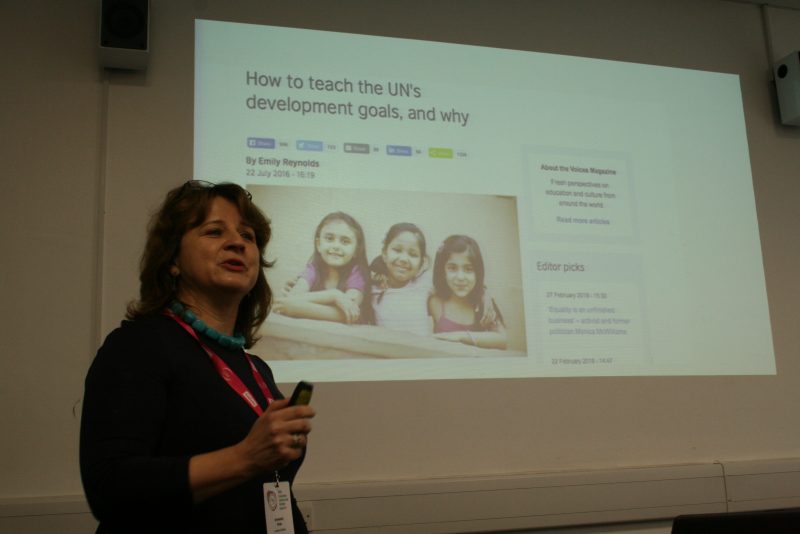
Viewing children as co-researchers signals a shift in the way we see children from passive objects to active and capable subjects. We can do research on and research about children, but what interests Annamaria is research with and research by children. And this is where Article 12 comes in. In research with and by children, they help gather data and ask questions, and to do this we need to give children agency. Within our school structures this can seem impossible. Agency and structure, according to sociology are opposites, and even the most liberal schools tend to have strong hierarchies and so fall within the definition of a ‘coercive organisation’. However, Annamaria went on to show us some very real possibilities for teachers everywhere.
She gave delegates a concrete example of a class which chose to have an English book corner where readers could freely select and exchange books. The children read, then told each other the stories and finally answered a questionnaire focusing on new words learnt, new knowledge and thinking skills and whether they enjoyed working with the stories or not. Whilst you could argue that this is simply child centred teaching, the final questioning enabled the children to explore the learning which had happened, adding that extra layer that we can call research.
Annamaria summed up with four key points. That agency leads to empowerment, that learner empowerment and teacher development feed off each other, that when research is undertaken by teachers then everyone will benefit, and finally that when given agency, children can and will focus on social justice or other relevant local development goals. It was an important reminder of how much we can achieve in our own classrooms, even if we start small we have the power to make major changes.
Harry Kuchah Kuchah
ELT in Sub-Saharan Africa: Respecting children’s language rights
Harry Kuchah Kuchah’s plenary explored children’s linguistic rights in Sub-Saharan Africa through his research projects focussing on the role of English language across the wider curriculum rather than just as a single subject. He brought to our attention the ways in which English medium instruction can be seen not only as a human right, but equally as an affront on human rights.
We can all agree that education is an entitlement for all children and it’s also true that education benefits from linguistic diversity. However, when considered in the context of Sub-Saharan Africa where there are over 2000 ethnic languages, that linguistic diversity gets much more complex. We know that mother tongue education is vital in developing self-confidence and self-perception, so what happens when children go to school in a language that is totally foreign to their home environment? There are at least 19 African countries where English is accepted as the de jure official language, and it can be argued that this limits access to education for children who don’t speak English. In some cases, English medium instruction is delayed until the end of primary school, but in others it’s introduced much earlier. As such English (or sometimes French), can take up 60% of the weekly timetable, drawing focus and attention away from other essential subjects.
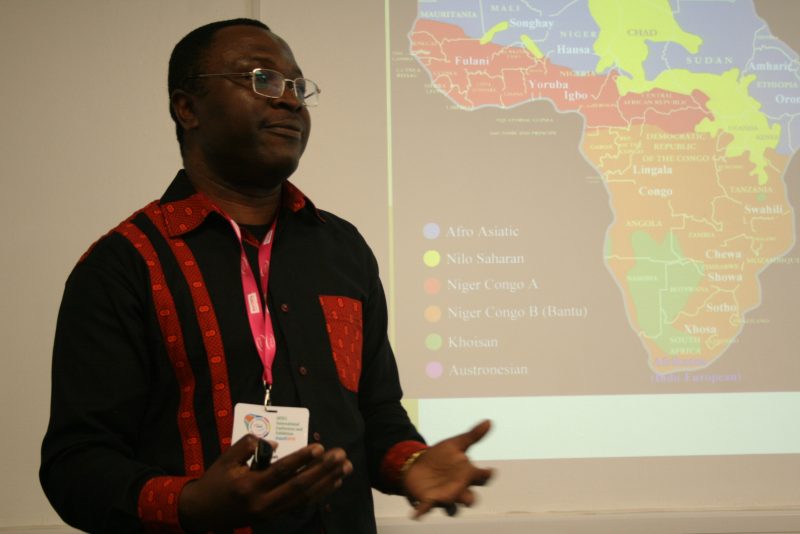
Harry discussed Article 26 of the declaration of human rights which states that parents / caregivers have the right to choose the kind of education their children receive, which at face value is incontrovertible. But again, the context is key. If only formal education is valued, then parents / caregivers have the power to choose the school and in certain contexts, the language of instruction. Whilst we would hope that most parents / caregivers have their child’s best interests at heart, they don’t always make their choices taking into consideration socio-economic circumstances. Research in Sub-Saharan Africa shows that parents / caregivers do recognise the value of local languages but prefer an international language for their children believing it will help them attain the benefits of a more elite and urban community. Often, many of these parents / caregivers can’t say a word in that international language, in our case English, but since they have a right to choose it must be respected. This in turn raises the question as to whether children indeed have any rights in this scenario.
Harry shared a project he has been working on with Francophone children in English medium schools. This explored the strategies used by children when negotiating their own learning and also what linguistic resources children were drawing on to complete tasks. The children all struggled with English and shifted between English and French during lessons, showing that translation and code-switching were integral to their learning. An example of a story writing task showed us that when children were left alone to complete the task they negotiated everything in French but produced a long and comprehensive text. Children who were observed by the teacher did the task in English only but produced a very short text.
Harry’s final thoughts highlighted the need to educate parents / caregivers to enable them to make good choices for their children, that English has the potential to be both a barrier and an enabler, that multilingualism plays a very important role in learning a language, and that languages grow through collaboration in the same way that human relationships do. We would all do well to remember that it’s local resources that bring a global language home to learners (Kuchah Kuchah).
Early Years TED Talks
Children’s language learning rights: Gail Ellis
Gail Ellis focused on children’s language learning rights taking Article 12 of the Rights of the Child as a starting point. She gave us a highly informative history of children’s language learning rights from the early 1980s to present showing a shift in the relationship between child and teacher to one of shared responsibility and control, respecting the here and now of childhood.
Gail asserted that the characteristics of effective teaching and learning in the early years classroom include play and exploration, active learning and creative and critical thinking amongst many others. Underpinning all of this is that each learner is unique, learns in different ways and at different rates and has different learning preferences. Whilst most research into learner autonomy in ELT focuses on adults, the development of autonomy is just as valid for children.
Children are often thought to be too young to express their views on their own learning, seen as doers, or consumers of activities rather than as decision makers with rights and responsibilities and according to Gail, it’s time we moved away from this. Given the right support, she maintained how children are fully capable and one area which proves this is self-reflection.
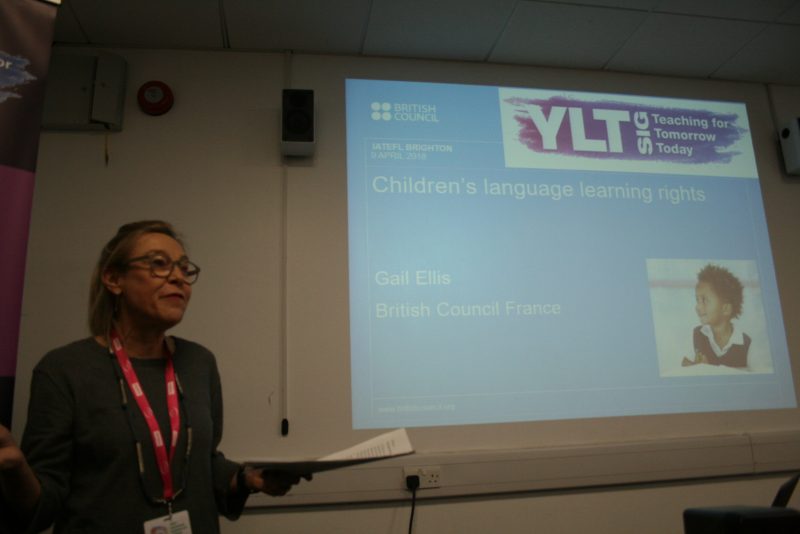
Gail shared practical guidance in the four areas of space, voice, audience and influence. By space we refer to giving children the space and opportunity to express a view. Voice refers to enabling children to express themselves. Audience means children’s views must be listened to and influence means acting upon this where appropriate. To do this, we need to ensure our learning environments are positive and that they support decision making by giving children resources to choose from. Key things which all teachers can provide are places to store work such as a language learning scrapbook, places to store personal belongings, quiet and busy areas and opportunities for large group, small group and solitary activities. We can provide children with concrete support in goal setting, opportunities to interact with both the teacher and peers and encouragement to express themselves.
Age appropriate ideas include using emojis to enable children to assess and explain their learning, visuals to help children review their favourite activities and puppets to engage children in talking about what they like doing most in English lessons. To conclude, Gail reminded us that respecting the rights of children is a legally binding obligation for which all of us in YL ELT are responsible.
Young little tech teachers – Early years learn from primary: Jen Dobson
Jen Dobson shared her fascinating action research into digital literacies and Sustainable Development Goal 9 which focuses on innovation. Innovation is clearly important, with 95% of the world’s population and 85% of people in the least developed world covered by a mobile cellular signal. Therefore, according to Jen, it’s never been more important to foster safe, creative and collaborative educational technology. Jen’s project took the premise that primary learners could learn and share tech knowledge with early years children, improving the awareness of digital literacies and English language of both age groups. The project resonated strongly with Annamaria’s talk on agency, and Gail’s talk on rights, with children working collaboratively with their teacher, classmates and younger students, with support at every stage but also with plenty of agency.
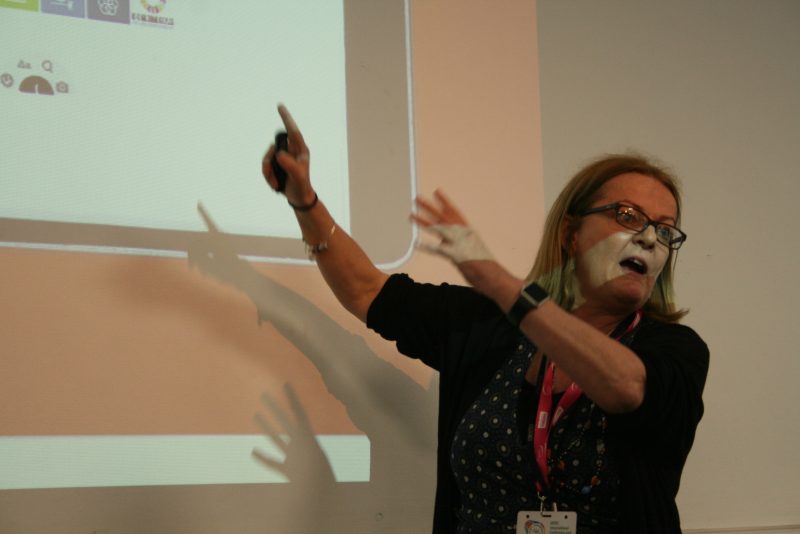
There were a number of steps which the students and their teachers went through. In the primary classroom:
- Primary learners discussed project ideas with their teachers. They discussed aims, task rubrics, apps and tools, content and related safety issues.
- The students obtained parent / caregiver permission to bring mobile devices to class and safety procedures were put in place. The apps children used were Tiny Tap, Art Maker and Skitch.
- The students, with the help of their teacher, worked on the language needed while making the game.
- Small groups made games.
- The students, with the help of their teacher, worked on the language needed to teach the game to the early years children.
In the early years classroom:
- The primary learners joined the early years children and taught them how to play the game.
- The primary learners then showed the early years children how to make the game.
It’s easy to imagine how much this project benefitted all the students involved through the choices, responsibility and autonomy they were given. Throughout, students were developing their social skills, sharing ideas, supporting their peers, thinking outside the box and working creatively. The structure Jen shared could easily be adapted to the needs of groups of learners studying all over the world.
Primary TED Talks
The right to my languages: multilingualism in children’s English classrooms: Nayr Ibrahim
Nayr Ibrahim’s aim was to highlight children’s language rights in the context of multiculturalism and to share how we can draw on their linguistic and cultural diversity. She gave us some excellent ideas of ways to bring children’s own languages into the classroom and asserted how important this is for their identities and sense of self. The talk referenced article 30 of the Rights of the Child which states the right to practice any culture, language or religion, and examined this in an EFL and bilingual language learning context. Traditionally, the mother tongue is excluded from this setting where we still function in a monolingual bias which, according to Nayr, denies our students the licence to be who they really are.
Nayr advocates instead allowing children to bring their own languages into the classroom since separating languages into different boxes is both unnatural and unnecessary. More and more often the classes we teach are made up of students from many different backgrounds and cultures and by bringing those cultures to the classroom we create rich learning opportunities.

She went on to focus on the bilingual section of her teaching and learning context in France where children are in fact largely multilingual. She shared ideas from teachers to open up the classroom to all the languages the children used. One idea was for children to bring objects which represented themselves. A child brought an ornament of a man in a robe standing next to a camel. The child spoke English, Spanish and French, and surprisingly the object represented English to them, since they had learnt English in Dubai.
Other excellent ideas shared by Nayr included ‘language silhouettes’ where the task was for students to draw their languages anywhere they wanted on a silhouette, revealing insights such as ‘French is where my brain is as I use it every day’ and ‘English is in my heart as it is emotional and imaginative language’. Similarly ‘language maps’ asked children to plot their languages on a map, deepening understanding and rapport between students and their teachers.
During all of these tasks, it’s inevitable that children will mix languages but as Harry showed us, this can in fact yield the best results. This may be through speaking or thinking in different languages in their heads, but in either case, drawing on the mother tongue is a very natural way to learn. Nayr finished with a lovely quote from one of her students, ‘My languages are my confidence, proudness, my achievement. It is my difference from the others. It is my power’.
Teaching primary children to make wise choices: Katherine Bilsborough
Katherine Bilsborough’s talk opened with a reminder that children have opinions even before they start talking. They make choices all the time, every day about things which affect their lives. In the classroom, however, very often all these choices stop. They no longer decide where to sit, what to do or say with all decisions being taken by the teacher. Understandably teachers can be scared about offering opportunities for choice, that chaos will be let loose or that it creates too much extra work, however, Katherine’s practical solutions proved that the extra work is minimal and that the benefits far outweigh any preparation time spent.
Katherine’s choice boards give children a range of tasks to choose from, and as she explained, the first step is to show children that each choice has a consequence. It’s key to allow children to make their own decisions, prepare for the task chosen but allow them to change their mind if they conclude that their choice was not necessarily the best one. Children have a tendency to do what their friends do, but may find themselves struggling realising they do not have the same strengths or preferences as their friend. We need to help children to make wise choices, and by doing that they need to make mistakes and work things out for themselves.
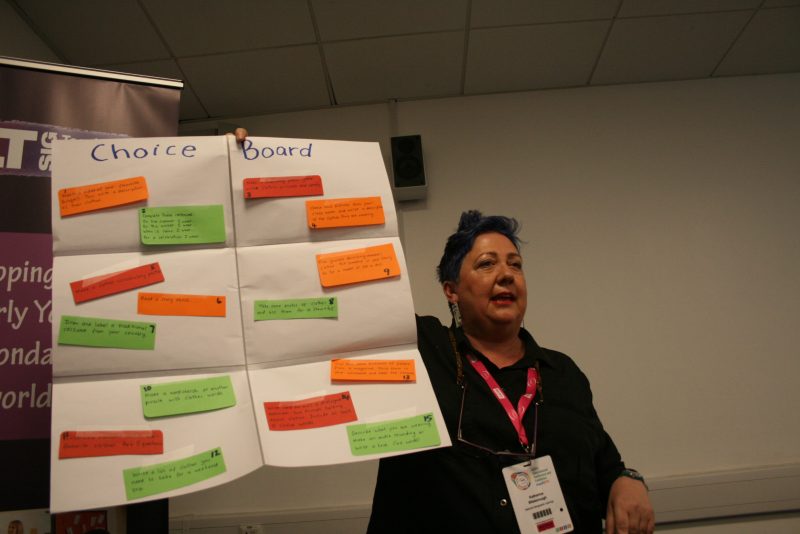
She then shared a number of choice board tasks for primary learners finishing a unit on clothes. Ideally, these would be displayed on the wall for children to go and choose a task to do. Some of Katherine’s ideas (she included 15 on her original board) included:
- Interview someone about their favourite clothes. Ask at least 5 questions.
- Write a packing list.
- Make a wordsearch.
- Write a description of two pictures in the class book.
- Label pictures of clothes from a magazine.
And providing the choices is only the start. Stronger students can be challenged to do two tasks. Later, children can come up their own tasks for the choice board.
Ideally we want children to make wise choices without the influence of the teacher, however, that does not mean that it has to be a choice made alone. Making choices with a friend in groups of two or three, potentially in L1, allows children to talk about the choices they are making and therefore think more deeply about them. Because not all choices will be wise all the time, as well as a five minute window in which to change their minds, Katherine also recommends a reflection stage. After completing their chosen task it’s key to reflect on how the task went, and whether or not the right choice was made. Asking them if they enjoyed the task or not is a good starting place for developing self-reflection skills.
Katherine finished by challenging us to try using choice boards in our classrooms, with a great idea of a summer holiday choice board – how to keep using English over the summer. Why not give it a go with your students and share the outcomes on YLTSIG social media?
Lower Secondary TED Talks
Using literature to help meet the SDG specific learning objectives: Laura McWilliams
Laura McWilliams’ talk shared insights into the re-writing of an intensive summer course for lower secondary where the focus was on developing essential life skills. Through looking at what was important to include – global citizenship, social responsibility and empathy and respect for others, the SDGs were arrived at. Linked to UNESCO’s cognitive, socio-emotional and behavioural learning objectives, the aim was to give students three main learning points. First an explicit knowledge of the goals, secondly an understanding of the goals on an emotional level and finally to be able to react to them.
One of the main challenges with teenagers is getting them to engage with a topic. Laura is based in France, and a lesson on heroes focussing on a recent hostage situation there surprisingly didn’t really elicit much of a reaction from her students. There is such a prevalence of this information in the news that such events have become somewhat normalised, and students often remained disassociated.
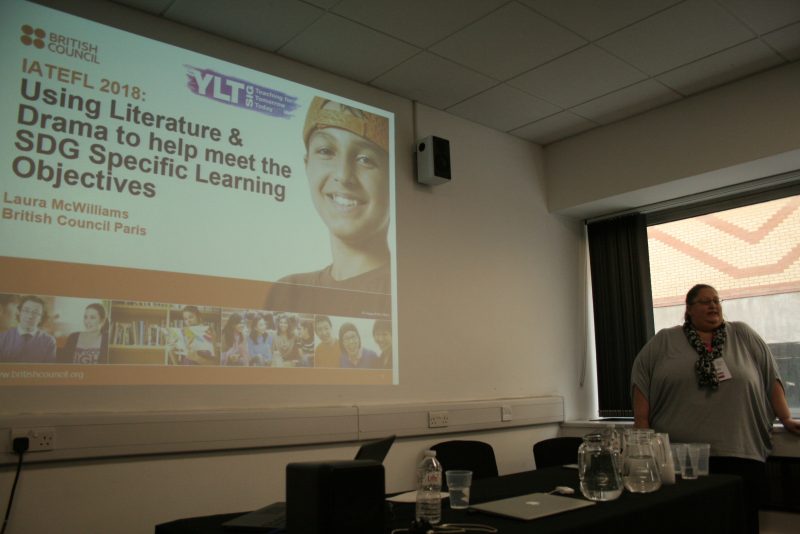
Laura went on to show us an excellent example of how teenagers use what is familiar to them to understand what’s happening in the world around them. Recent protests in the USA over gun ownership have featured a number of placards with Harry Potter references showing how important literature is to teenagers. Therefore, drama and literature were identified for the intensive holiday course as ways to allow students to experience something new through someone else’s skin.
She shared a number of practical ideas for using drama, literature and the SDGs in the classroom. I particularly liked ‘Hot seating’, where students immerse themselves in a character while the rest of the class ask them questions. This needs to be with literature they’ve studied either via a graded reader or authentic text, and does not have to be the hero or heroine. It could be a character who is not sympathetic, or isn’t someone they aspire to be. ‘Who am I?’ entails asking one student to leave the room while the rest of the class create a freeze frame of a moment in the book. On their return to the classroom the student has to find their place in the tableaux and work out who they are. Another excellent idea was ‘Thought tracking’. For this, each student is assigned a character, Laura used the example of Emily Pankhurst. As the scene is played out, freeze framing from moment to moment, students share what is going through their characters’ heads allowing them to tap into the emotion at each stage of the scene. Any image can be taken as a start point, with Rosa Parks being another thought provoking place to start.
Empowering children through the Sustainable Development Goals: Carol Read
Carol Read’s talk focused on how to introduce the SDGs, looking at what the goals are and how to use them in the classroom in order to enrich children’s language development and increase their awareness of social justice issues, both globally and in their local context. The theme of empowerment was present in all the activities Carol shared, enabling children to become stronger, more confident and more independent as well as more able to take responsibility for their learning and control of their lives. Pertinent to this age group, there was plenty of enjoyment as well as opportunities for critical and creative thinking during the session with a number of activities to use in the classroom.
For one activity Carol gave us short descriptions of the goals, written in child friendly language. Our task was to identify the goal. This could be done as an open class team activity, or as a small group or pair work using matching cards, with a follow-up activity of ranking the goals in order of priority and discussing this. There is a wealth of activities available online at http://worldslargestlesson.globalgoals.org/ but since these are not designed for language learners a certain amount of adaptation is needed to make them friendly for the ELT classroom. This led Carol to the idea of creating a course around the goals specifically for lower secondary English language learners to either supplement or replace an ELT coursebook. She shared an example of how to go about this with goal 15, Life on land. A spidergram of topics included ideas such as how plants grow, animal camouflage, food and food chains and endangered animals amongst others. An example of curriculum objectives showed how this might be developed specifying suggested learning outcomes, cognitive skills, main language, vocabulary and values. Echoing the sub theme of giving children choices, learners can then identify the topics they want to study and collaborate with the teacher in order to organise and sequence their chosen content into motivating and relevant learning materials.
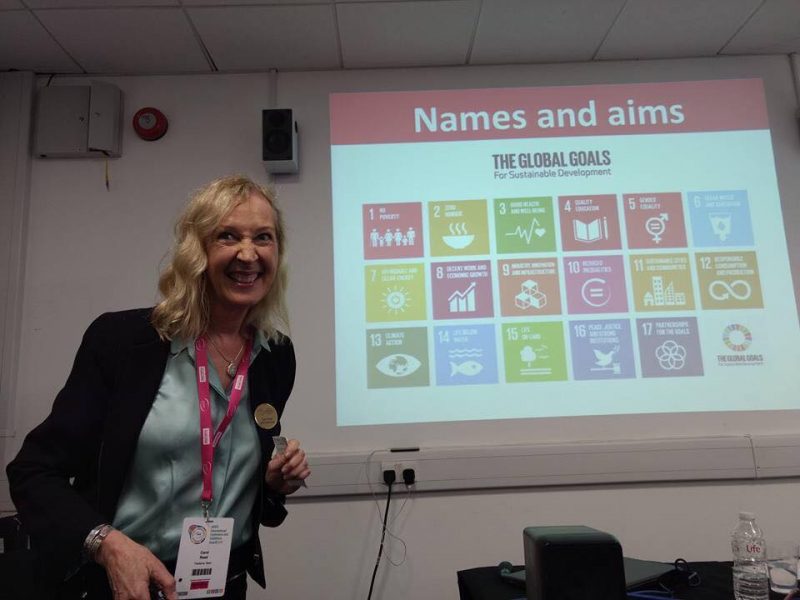
Another excellent suggestion, based on an idea from the World’s Largest Lesson materials, was that of a class debate ‘the global goals are a waste of time’. To enable lower secondary learners to participate fully it can help to give role cards, or, alternatively, to use a more multisensory approach to helping children decide where they stand on the issue by having them position themselves on an actual line showing the continuum from ‘agree’ to ‘disagree’ in the classroom. Carol made the point that we can expect to be surprised by the level of maturity of our students’ responses. It’s true we often underestimate what our young learners are capable of and must remember this when planning lessons and selecting materials.
Carol finished her session by showing us a short video of an eleven-year-old child from Uganda, Noah, thanking children from a school in Madrid for their fundraising activities to make improvements to Noah’s school. The video gave us tangible evidence of how children in many different educational contexts can get involved in meeting the SDGs and underlined Carol’s final message urging us to ‘use the global goals to open children’s eyes to the world they live in and make learning more meaningful, engaging and worthwhile’.
Upper Secondary TED Talks
Using songs for social change with upper secondary learners: Rachael Pooley
Rachael Pooley talked about her previous experiences of living in Myanmar (she is currently based in Bangkok, Thailand) which is a country with serious human rights issues. She also shared insights from a return visit to a conference in Yangon in 2017 which featured a session on the SDGs and how they interplay with what is happening in the country. She was interested that whilst teachers came from many different ethnic groups and despite prevailing ethnic tensions in the country, they were able to engage in meaningful dialogue through and around songs, notably ‘Imagine’ which includes six of the goals.
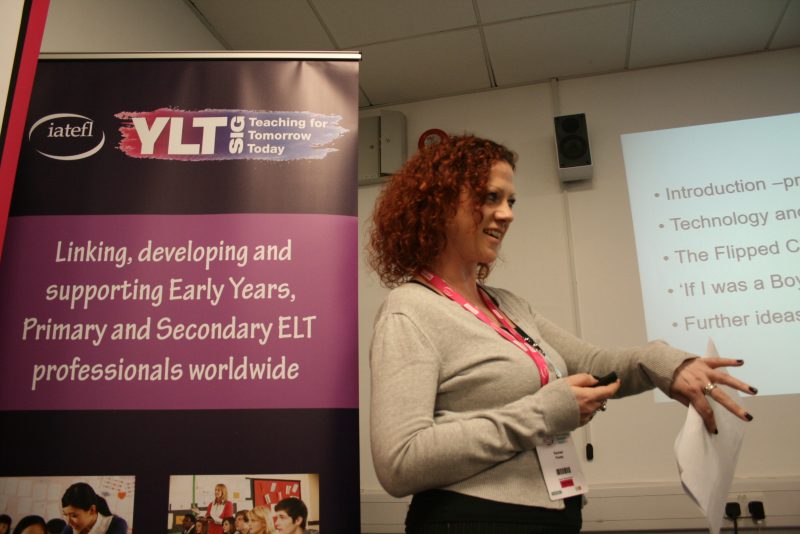
In Rachael’s flipped classroom, where the students do the groundwork at home to save class time for higher order thinking skills with the teacher present to guide, she uses technology and a diversity and inclusion focus wherever possible to engage students in their learning. One example was the song ‘Freedom’ by Beyonce which she used to powerfully mark the International Day of the Girl. By using the hashtag, the students were able to read tweets about what freedom meant for girls around the world, and were surprised to see how different things were for different genders outside the relative gender equality of Bangkok.
Rachael shared a number of higher order thinking tasks for use in the upper secondary classroom, such as analysing the message of songs which call for social change (Jackson’s ‘Earth Song’, Queen’s ‘I want to break free’), writing verses for songs (she shared examples from her classroom where students wrote about bullying and interacting with different genders) and debates about gender equality both at home and around the world.
I was struck by how much learning can be gained from familiar songs which will be within our teenage students’ frames of reference but whose messages they may not have fully grasped. A real learning opportunity for all working with this age range!
Teen projects against modern slavery and trafficking: Judy Boyle
Judy Boyle concluded the day with a powerful and shocking overview of modern slavery and human trafficking in the particular context of teenagers from the upper secondary age range. The real, lived stories of abuse as well as the statistics she shared are truly heart breaking and warrant significant attention leading to action both inside and beyond the upper secondary ELT classroom. Judy also referred to a rich variety of creative ideas to raise teenagers’ awareness of and take action against trafficking and slavery via the language arts. These and many other sources of inspiration can be found on the superb website from The NO Project http://www.thenoproject.org/ Judy finished by reading a moving poem written by a teenager from one the many learning and teaching contexts she has been working with recently.
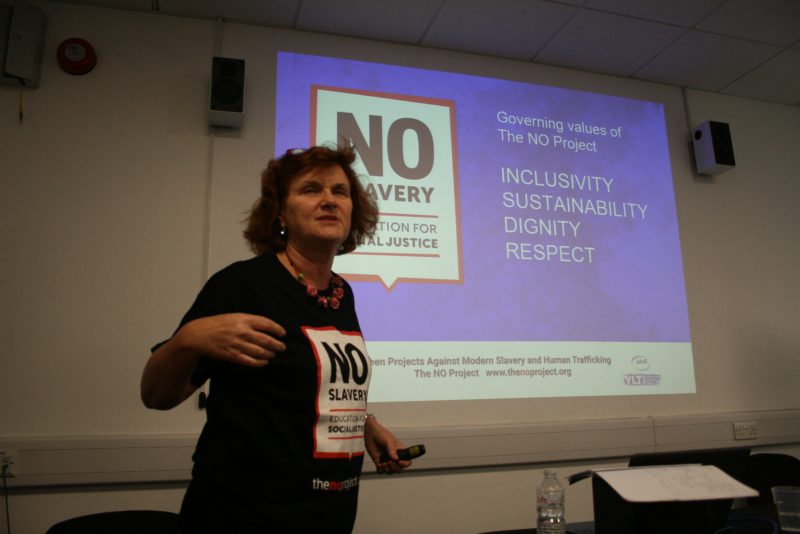
For additional practical ideas about exploring modern slavery and human trafficking in upper secondary ELT, YLTSIG members can read the hot topics feature in our newsletter TEYLT Worldwide Issue 1 2018 by YLTSIG Coordinator, David Valente.
